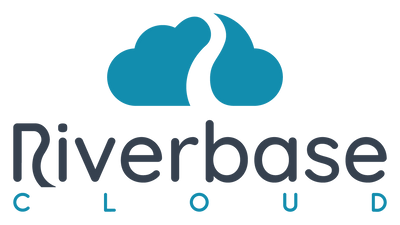Why Content Teams Are Racing to Adopt AI-Powered Management
AI-powered content management systems are changing how businesses create, organize, and distribute content by combining artificial intelligence with traditional CMS capabilities. Here's what you need to know:
Key AI-Powered Content Management Features: • Automated content creation - Generate drafts, headlines, and copy variations • Smart content organization - Auto-tag, categorize, and classify content • Intelligent search - Natural language queries across all content types • Personalization at scale - Dynamic content delivery based on user behavior • Workflow automation - Streamline review, approval, and publishing processes • Multi-language support - Instant translation into 100+ languages • SEO optimization - Real-time suggestions and performance tracking
The numbers tell the story: 74% of US marketers already use generative AI to improve their marketing strategies, while an additional 23% plan to invest soon. Organizations implementing AI-powered content management see dramatic results - including 10× faster content production, 80% lower administration costs, and 320% return on investment.
Traditional content management feels slow and manual compared to what's possible today. Content teams struggle with bottlenecks, inconsistent quality, and the growing demand for personalized experiences across multiple channels. AI changes this equation completely.
Instead of writers staring at blank pages, AI suggests topics and creates first drafts. Rather than manually tagging thousands of images, AI handles metadata automatically. Instead of guessing what content resonates, AI analyzes performance and optimizes in real-time.
I'm Gary Gilkison, founder of Riverbase Cloud, where I've spent years helping SMBs leverage AI-powered content management to scale their digital marketing without the complexity. My experience building marketing automation systems has shown me how the right AI tools can transform content operations from a cost center into a growth engine.
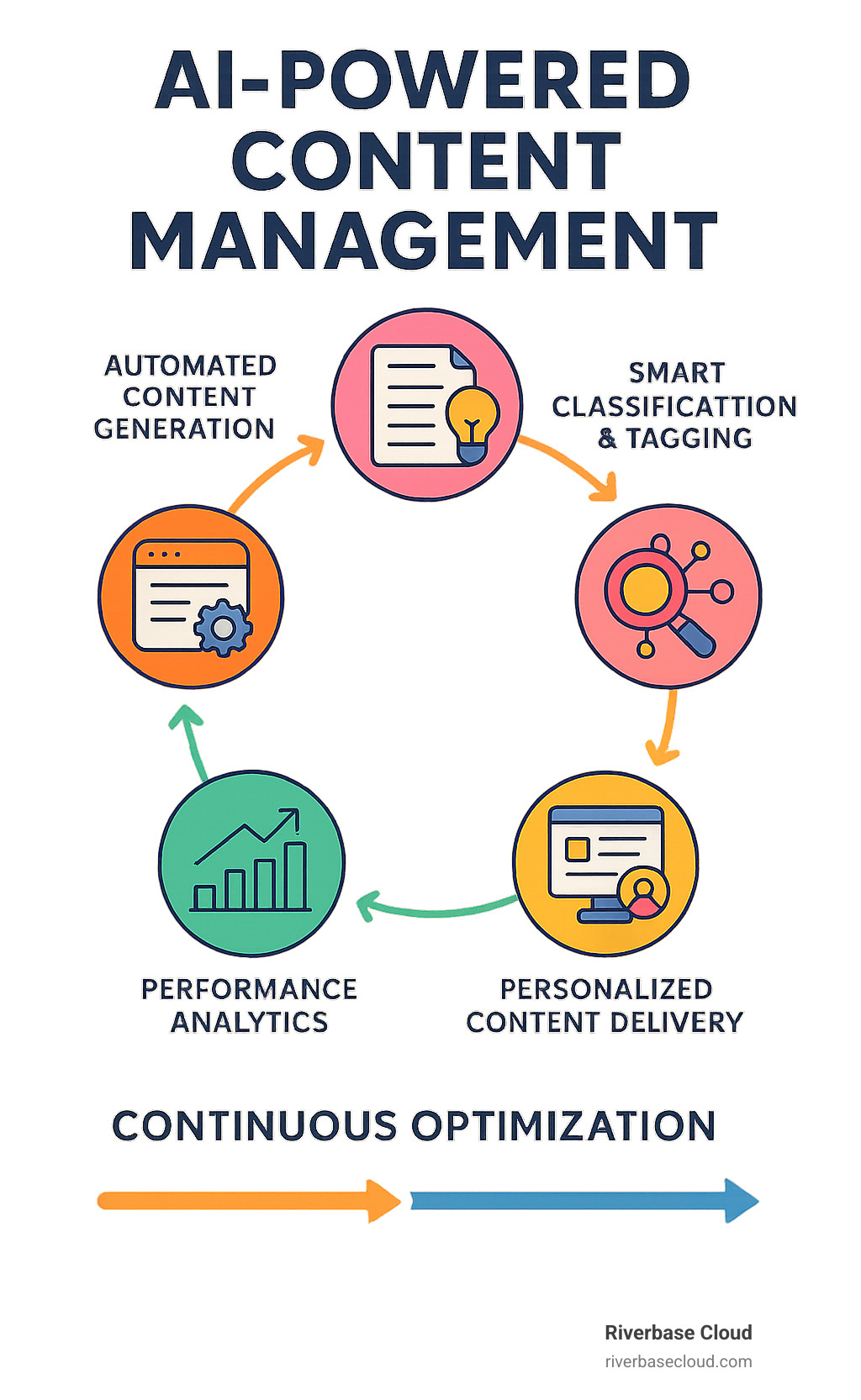
Explore more about AI-powered content management:
- Managed-AI CONTENT SEO
- Google ranking optimization
- digital marketing solutions
1. What Sets AI-Powered Content Management Apart from Traditional CMS?
Think about the last time you used a traditional CMS. You probably spent hours writing content from scratch, manually tagging images, and guessing which headlines would perform best. Traditional content management systems were built for a simpler time when content teams had weeks to craft the perfect blog post.
AI-powered content management changes everything. Instead of being a passive storage system, it becomes your creative partner. While legacy CMS platforms simply store and display content, AI-powered systems actively help you create, optimize, and distribute content that actually works.
The difference is like comparing a filing cabinet to a personal assistant. Your old CMS was basically a digital filing cabinet—useful for organizing content you already created, but not much help with the actual creation process. An AI-powered system is more like having a brilliant assistant who knows your brand voice, understands your audience, and can draft content faster than you can type.
Here's what this looks like in practice: Legacy suites require manual workflows for everything. You write content, manually categorize it, hope people find it through basic keyword searches, and cross your fingers that it resonates. AI-powered systems use machine learning engines to suggest topics, natural language processing to understand user intent, and generative AI to create first drafts that sound like your brand.
| Feature | Traditional CMS | AI-Powered CMS |
|---|---|---|
| Content Creation | Manual writing and editing | AI-assisted drafting with human oversight |
| Organization | Manual tagging and categorization | Automated classification and metadata enrichment |
| Search | Keyword-based queries | Natural language and semantic search |
| Personalization | Static content blocks | Dynamic, behavior-driven content delivery |
| SEO Optimization | Manual keyword research and optimization | Real-time suggestions and automated improvements |
| Translation | Manual or outsourced translation | Instant AI translation into 100+ languages |
| Analytics | Basic traffic and engagement metrics | Predictive analytics and performance optimization |
| Workflow | Linear approval processes | Smart review queues with automated routing |
The automation versus manual approach extends to omnichannel delivery too. Traditional systems make you manually format content for each platform—one version for your website, another for social media, and yet another for email. AI-powered systems automatically adapt your content for different channels while maintaining consistent messaging and governance across all touchpoints.
Key Architecture Shifts
Modern AI-powered content management systems accept what's called headless architecture. Don't let the technical term scare you—it simply means the content management backend is separated from how content actually appears on your website. This separation is connected through APIs, which are like digital bridges that let different systems talk to each other.
This composable DXP (digital experience platform) approach might sound complex, but it's actually what makes AI integration possible. Think of it like building with Lego blocks instead of carving everything from a single piece of stone. You can add AI capabilities piece by piece without rebuilding your entire content system.
Microservices make this flexibility possible. Need better image recognition for your product photos? Plug in a computer vision API. Want smarter content recommendations? Add a personalization engine. Each AI capability works independently, so if one needs updating, it doesn't break everything else.
The API-first design ensures your content flows seamlessly between AI tools, analytics platforms, and delivery channels. Your CMS becomes the central hub of an intelligent content ecosystem rather than an isolated island.
Cloud-native architecture handles the heavy computational lifting that AI requires. When an AI model analyzes thousands of images or generates content variations, cloud infrastructure scales automatically to handle the workload without slowing down your website.
Smart Review Queues & Versioning
Here's where AI-powered content management gets really smart about governance. Traditional CMS platforms weren't designed for scenarios where AI might optimize hundreds of pages overnight. They assume humans review every single change, which becomes impossible at AI speeds.
Smart review queues use anomaly detection to flag content that actually needs human attention while automatically approving routine improvements. Instead of drowning editors in approval requests for minor SEO tweaks, they can focus on strategic content decisions and unusual modifications that require human judgment.
Git-like versioning lets content teams branch AI-generated changes, review them safely, and merge approved updates without overwriting human work. If an AI translation doesn't capture your brand voice correctly, you can roll back to the previous version without losing other valuable improvements the AI made.
Improved audit trails capture not just who made changes and when, but also which AI model was used, the confidence score, and the reasoning behind each decision. This transparency becomes crucial for compliance requirements and quality control, especially when you need to explain why certain content decisions were made.
AI guardrails ensure that automated changes stay within your brand guidelines and content policies. These work like bumpers in a bowling alley—they keep AI-generated content in the right lane while still allowing for creativity and optimization.
2. AI-Powered Content Management: 7 Instant Wins for Your Team
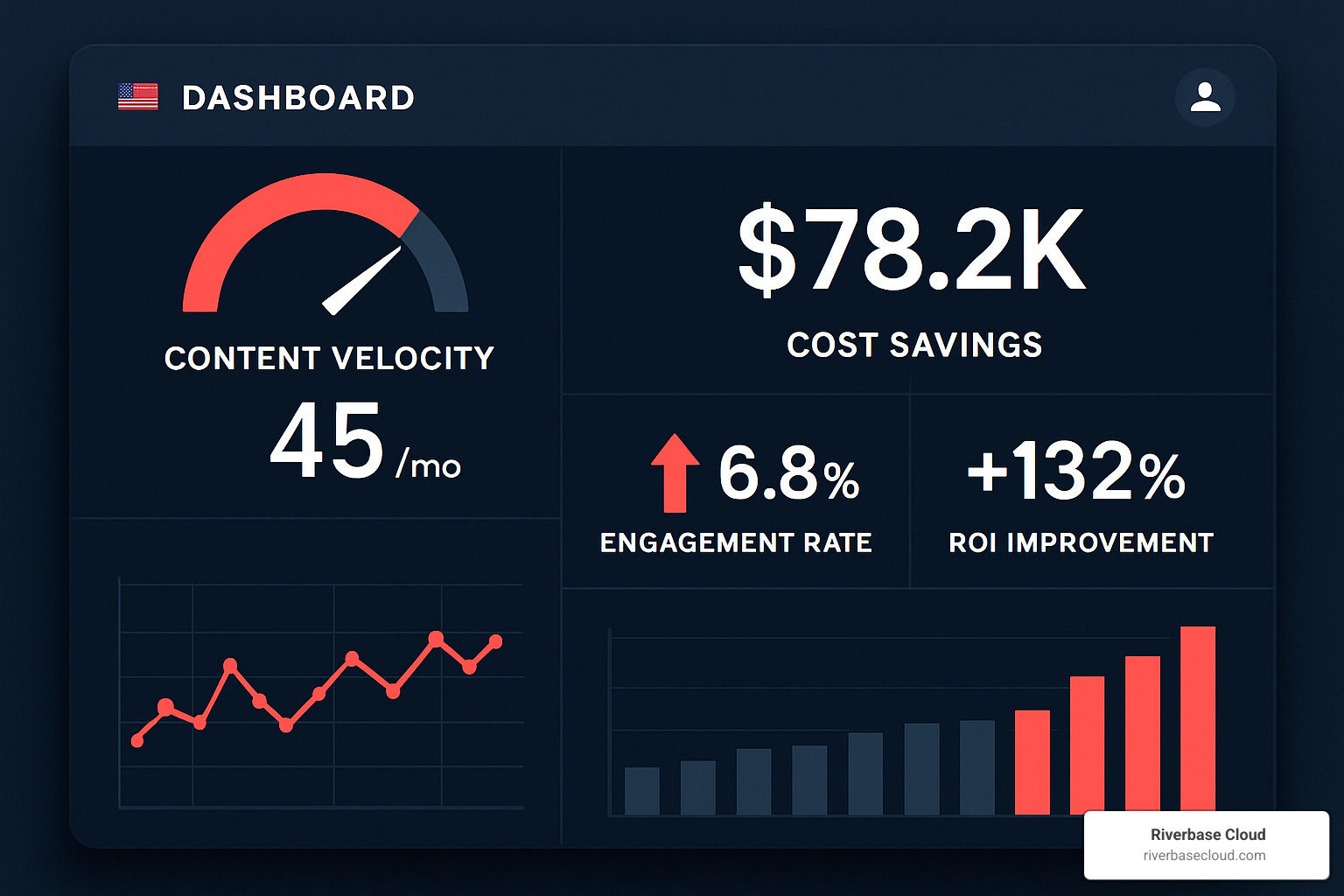
When we implement AI-powered content management for our clients at Riverbase Cloud, we consistently see seven immediate improvements that transform how teams operate. Let's explore each benefit with real data from organizations already using these systems.
Benefit #1: 10× Faster Content Creation
The most dramatic improvement comes from AI-assisted content creation. Large language models can draft blog posts, product descriptions, and social media content in minutes rather than hours.
Dentsu, a global marketing agency, achieved exactly this result. By empowering content authors to update copy in real-time without relying on developers, they created content 10× faster. Their Author Assist features include:
- Topic ideation: AI suggests content ideas based on trending keywords and competitor analysis
- First draft generation: Complete articles written from brief outlines
- Tone adjustment: Content automatically adapted for different audiences and channels
- SEO optimization: Real-time keyword suggestions and readability improvements
The key is maintaining human oversight. AI handles the heavy lifting of research and initial drafting, while human editors focus on strategy, brand voice, and final polish.
Benefit #2: 80% Lower Admin Costs
Content administration traditionally consumes enormous amounts of time. Manually tagging images, categorizing articles, and managing metadata across thousands of assets becomes a full-time job.
Organizations using AI-powered content management solutions report an 80% decrease in content administration costs through automation:
- Automated tagging: AI analyzes images, videos, and documents to generate accurate metadata
- Workflow automation: Content automatically routes through approval processes based on type and sensitivity
- Mission Control dashboards: Real-time insights into content performance and team productivity
Benefit #3: 286% More Engagement
Personalization drives engagement, but manual personalization doesn't scale. AI changes this by analyzing user behavior and delivering custom content experiences automatically.
Organizations see a 286% increase in customer engagement after implementing AI-powered personalization:
- Behavioral targeting: Content recommendations based on browsing history and preferences
- Dynamic content blocks: Page elements that adapt based on user characteristics
- Predictive recommendations: AI suggests next-best content to keep users engaged
Benefit #4: 320% ROI
The Total Economic Impact studies show organizations achieve a 320% return on investment with AI-powered content management systems. This ROI comes from multiple sources:
- Reduced content creation costs: Faster production with smaller teams
- Improved conversion rates: Better personalization drives more sales
- Operational efficiency: Automated workflows eliminate manual bottlenecks
- Faster time-to-market: New campaigns launch in hours instead of weeks
American Bath Group provides a perfect example: they reduced deployment time from 30 hours to 3 minutes by switching to an AI-powered CMS.
Benefit #5-7: Localization, Governance, Developer Velocity
Three additional benefits round out the immediate wins:
Instant Localization: AI translates content into nearly 100 languages while maintaining context and tone. This opens global markets without hiring translation teams.
Automated Governance: AI enforces brand guidelines, checks compliance requirements, and flags potential issues before publication. Content stays on-brand even when multiple teams contribute.
Developer Acceleration: Developer Assist features provide code snippets, templates, and automated deployments. Technical teams save 30% of their time on routine content management tasks.
OpenText Blogs showcases many of these benefits in action across enterprise implementations.
3. 5 Ways AI Automates the Content Lifecycle (Creation → Distribution)
AI-powered content management completely transforms how content moves from initial spark to final publication. Instead of manual handoffs between team members, AI creates a seamless pipeline that keeps content flowing efficiently.
Think about your current content process. Someone brainstorms ideas, another person writes, editors review, designers create visuals, and finally someone publishes across different channels. Each step takes time and coordination. AI automation changes this by handling routine tasks while humans focus on strategy and creativity.
Creation & Ideation
The dreaded blank page becomes a thing of the past when AI handles initial content creation. Modern systems analyze what's trending in your industry, what competitors are publishing, and what your audience actually engages with.
Generative copy creation starts with simple prompts but produces complete articles, product descriptions, and marketing materials. The secret is giving AI enough context about your brand voice and target audience. You're not getting generic content—you're getting drafts that sound like your company.
Image generation eliminates the endless search through stock photo libraries. AI creates unique visuals, infographics, and illustrations custom to your specific content. Need three different hero images for A/B testing? AI generates them in minutes.
Tone adjustment means one piece of content works across multiple channels. That detailed technical blog post automatically becomes a LinkedIn snippet, an email newsletter section, and a Twitter thread—each perfectly formatted for its platform.
Brand voice consistency ensures everything sounds like it came from the same team, even when multiple people (and AI assistants) contribute to content creation.
Curation & Classification
Once content exists, AI automatically organizes it in ways that make future findy effortless. This isn't just about filing things in folders—it's about understanding what content actually means.
Semantic analysis groups related content even when it uses different terminology. Articles about "automobiles," "cars," and "vehicles" get connected because AI understands they're discussing the same topic.
Sentiment tagging helps teams understand the emotional impact of their content. Is this blog post encouraging or concerning? Will this product description excite customers or confuse them? AI flags the emotional tone automatically.
Knowledge graphs map relationships between topics, creating intelligent content hierarchies. When someone searches for information about email marketing, AI knows to also suggest content about automation, segmentation, and analytics.
Automated taxonomy replaces the tedious process of manually creating category structures. AI analyzes your existing content and suggests the most logical organization scheme.
Search & Findy with AI-Powered Content Management
Finding the right content becomes as easy as having a conversation when AI powers your search capabilities. No more hunting through folders or trying to remember exact keywords.
Cross-format search means asking questions in plain English and getting answers from documents, videos, images, and audio files. AI understands intent, not just keywords, so "What were our best products last quarter?" finds sales reports, performance videos, and customer testimonials.
Conversational queries eliminate the guesswork from search. Instead of wondering whether to search for "Q2 sales," "second quarter revenue," or "spring performance," you simply ask what you want to know.
Intent detection helps AI recognize what users actually need, even when their search terms are imprecise or incomplete.
Box AI's approach to enterprise content search shows how conversational search transforms how teams access information across massive content libraries.
Personalization on Autopilot
Manual personalization means guessing what different audiences want. AI personalization uses actual behavioral data to deliver exactly the right content to each visitor.
Behavioral analysis tracks how users interact with your content—what they read completely, what they share, what makes them bounce. This creates detailed preference profiles without requiring surveys or forms.
Multi-armed bandit testing continuously optimizes content delivery by automatically sending more traffic to better-performing variations. Unlike traditional A/B testing that requires manual setup and analysis, this happens automatically in the background.
Dynamic content blocks change based on user characteristics, location, device, and browsing history. The same webpage shows different case studies to prospects versus existing customers, or different product recommendations based on previous purchases.
Predictive recommendations suggest next-best content to keep users engaged and guide them through your conversion funnel. Services like Ninetailed specialize in this type of intelligent content delivery.
Distribution & Omnichannel
Getting content to the right audience through the right channels at the optimal time becomes automatic with AI-powered distribution systems.
Headless delivery sends content to websites, mobile apps, social media platforms, email systems, and emerging channels through API connections. Create once, distribute everywhere—but with platform-specific optimization.
Channel-aware formatting automatically adapts content for different platforms. AI shortens copy for Twitter's character limits, adds visual elements for Instagram, optimizes subject lines for email newsletters, and adjusts layouts for mobile devices.
Automated scheduling analyzes engagement patterns to determine when your audience is most active on each platform. Instead of guessing when to post, AI publishes content when it's most likely to be seen and shared.
Adaptive user experience adjusts content presentation based on device capabilities, internet connection speed, and user preferences. Fast connections get high-resolution images, while mobile users see optimized layouts that load quickly.
This end-to-end automation doesn't replace human creativity—it amplifies it. Content teams spend less time on routine tasks and more time on strategy, brand development, and building relationships with their audience.
4. Under the Hood: AI for Search, Findy & Personalization
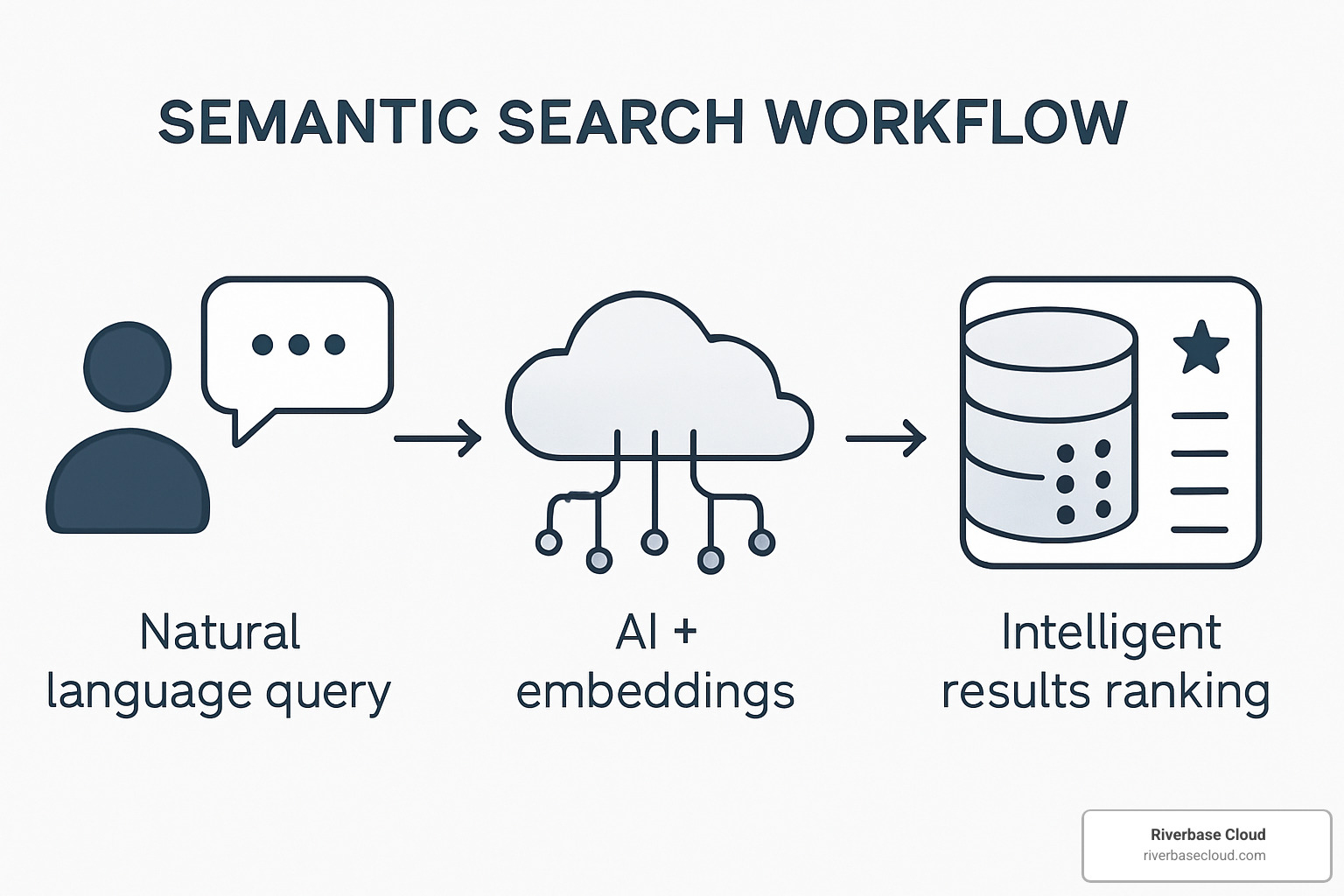
Ever wonder why some search results feel almost telepathic while others leave you frustrated? The secret lies in the sophisticated AI engines powering modern AI-powered content management systems. These aren't your grandfather's keyword-matching search boxes—they're intelligent systems that actually understand what you're looking for.
Think about it this way: when you ask a human colleague "Where's that report about our best customers last month?", they don't just look for those exact words. They understand you probably mean the quarterly analysis, customer satisfaction survey, or sales performance data. AI search works the same way.
NLP & Semantic Search Engines
Natural Language Processing transforms how we interact with content systems. Instead of learning complicated search syntax, you can simply ask questions the way you naturally think about them.
Semantic understanding means AI grasps the meaning behind your words, not just the words themselves. When someone searches for "boost website visitors," the system knows they want information about SEO strategies, content marketing, and digital advertising—even if those exact terms aren't in their query.
Intent mapping goes deeper by analyzing context. A search for "Apple" could mean the fruit, the tech company, or even Apple Records, depending on what else the user has been viewing. AI considers browsing history, user behavior patterns, and contextual clues to deliver the right results.
Modern AI-powered content management systems use advanced ranking algorithms similar to Google's RankBrain. These algorithms evaluate how real users interact with content, not just how many times keywords appear. Content that genuinely helps people rises to the top.
Conversational queries feel natural because they mirror how we actually think. Instead of typing "Q4 enterprise customer content performance metrics," you can ask "What content worked best with our big clients last quarter?" The AI understands exactly what you need.
Rich-Media Intelligence
Here's where AI really shows off. Traditional content systems struggle with anything that isn't text, but AI-powered platforms treat images, videos, and audio as searchable, organized content.
Video transcription happens automatically, converting every spoken word into searchable text. This doesn't just help with findy—it makes your content accessible to hearing-impaired users and improves SEO rankings.
Image recognition goes beyond simple file names. AI analyzes what's actually in your photos and graphics, generating detailed metadata automatically. It can identify products, people, emotions, settings, and even brand elements without human input.
Audio sentiment analysis listens to tone and emotion in recorded content. Customer service calls, podcasts, and video presentations get tagged with emotional context, helping teams understand not just what was said, but how it was received.
Accessibility improvements flow naturally from this rich-media understanding. AI generates accurate alt text, captions, and audio descriptions automatically, ensuring your content reaches everyone.
Organizations using these systems can now search across 160+ repository types and 2,000+ file formats using simple conversational language. No more hunting through folders or remembering exact file names.

Real-Time Personalization via AI-Powered Content Management
The most impressive aspect of modern AI-powered content management isn't just finding content—it's delivering exactly the right content to each person automatically.
Predictive segmentation works like having a mind-reading marketing assistant. AI analyzes how users behave on your site, what they click, how long they stay, and what they ignore. From these patterns, it builds detailed preference profiles without asking a single survey question.
Content affinity modeling tracks which topics, writing styles, and content formats resonate with different user types. Some people prefer detailed technical guides, others want quick visual summaries. AI learns these preferences and adjusts recommendations accordingly.
Dynamic content assembly creates personalized experiences on the fly. Instead of building separate pages for different audiences, AI combines modular content blocks to create custom experiences for each visitor. The same product page might emphasize technical specifications for engineers and cost savings for procurement managers.
Real-time optimization means the system gets smarter throughout each user session. If someone starts reading a technical article but quickly bounces to simpler content, AI adjusts future recommendations to match their apparent expertise level.
This level of personalization happens automatically, continuously, and invisibly. Users just experience content that feels perfectly custom to their needs and interests.
For deeper insights into how AI transforms marketing automation, explore our guide on using AI for smarter marketing automation.
5. Measuring ROI, Security & Overcoming Challenges
Let's be honest—implementing AI-powered content management sounds exciting until you start wondering about the practical stuff. How do you prove it's actually working? What about security risks? And how do you get your team on board without causing chaos?
These are the questions that keep business leaders up at night. The good news is that thousands of organizations have already walked this path, and we've learned what works (and what doesn't).
Analytics & Dashboards
The beauty of modern AI-powered content management platforms is that they're built with measurement in mind. Unlike traditional systems where you're flying blind, AI platforms give you crystal-clear visibility into what's happening with your content.
Mission Control dashboards become your new best friend. These real-time command centers show you everything that matters: how fast your team creates content, which pieces drive the most engagement, and exactly where your ROI comes from. No more guessing whether your content strategy is working.
Predictive analytics take this a step further. Before you even publish that blog post, AI can forecast how it's likely to perform. This means you can focus your energy on high-impact content instead of crossing your fingers and hoping for the best.
Anomaly detection acts like an early warning system. When something unusual happens—maybe a piece of content suddenly goes viral or engagement drops unexpectedly—you get automatic alerts so you can respond quickly.
The metrics that matter most include content velocity (how quickly you move from idea to published piece), engagement rates like click-throughs and time spent reading, conversion impact that ties content directly to business results, and cost efficiency that shows how much bang you're getting for your content buck.
Security, Privacy, Compliance
Security concerns about AI are totally understandable. You're essentially inviting a robot to handle your valuable content—what could go wrong?
The reality is that enterprise-grade AI-powered content management systems take security seriously. Granular permissions ensure that AI respects the same access controls your human team follows. If someone shouldn't see sensitive financial data, neither will the AI.
Data residency controls let you keep content processing within specific geographic boundaries. This is crucial for companies dealing with GDPR, CCPA, or other regulatory requirements that dictate where data can live.
SOC 2 compliance and Responsible AI principles mean leading platforms won't train their models on your proprietary content without explicit permission. Your competitive secrets stay secret.
Comprehensive audit trails track every AI action, including which model version was used, confidence scores, and the reasoning behind decisions. When auditors come knocking, you'll have the documentation they need.
Common Pitfalls & How to Solve Them
Every AI implementation hits predictable bumps in the road. Here's how to avoid the most common ones:
Model drift happens when AI performance slowly degrades as content patterns change over time. Think of it like a car that needs regular tune-ups. The solution is ongoing model retraining and performance monitoring—something good platforms handle automatically.
AI hallucinations sound scarier than they are. Sometimes generative AI creates content that sounds plausible but isn't factually correct. The fix is maintaining human oversight for important factual content and integrating automated fact-checking where possible.
Integration debt can sneak up on you. Connecting AI tools with existing systems gets complex fast. Choose platforms with robust API ecosystems and don't be afraid to invest in professional implementation support upfront.
Cost creep happens when AI processing expenses spiral out of control. Set usage limits from day one and monitor spending through your platform's controls. Most organizations find the ROI more than justifies the costs, but tracking prevents surprises.
Governance gaps emerge when AI makes content creation so easy that teams start bypassing quality controls. Smart review queues and maintained approval workflows for strategic content solve this problem.
Change management might be your biggest challenge. People worry that AI will replace them or make their skills obsolete. The truth is that AI handles the tedious stuff so humans can focus on strategy, creativity, and relationship building. Clear communication about AI's role as a tool, not a replacement, helps teams accept the change.
Our guide on SEO Evolution: Embracing AI for Better Results explores how to steer these transitions while improving your content performance.
Frequently Asked Questions about AI-Powered Content Management
When businesses consider implementing AI-powered content management, they usually have three burning questions. I've answered thousands of these inquiries while helping SMBs at Riverbase Cloud steer their AI content journey, so let me share the most honest answers I can give.
How does AI improve SEO and content quality?
The change happens in ways that honestly surprised me when I first started working with AI content systems. AI-powered content management doesn't just make SEO easier—it makes it smarter.
Real-time optimization changes everything about how content gets created. Instead of writing an article and then checking if it's SEO-friendly, AI guides you while you write. It suggests keywords that actually make sense in context, flags readability issues before they become problems, and scores your content against ranking factors in real-time.
But here's what really matters: semantic content creation. AI understands what searchers actually want when they type queries. When someone searches "how to fix slow website," they're not just looking for technical solutions—they want to understand why their site is slow and get actionable steps they can handle themselves. AI helps create content that matches this deeper intent.
The technical SEO automation saves enormous amounts of time. Schema markup gets generated automatically. Meta descriptions write themselves based on content. Heading structures follow best practices without you thinking about it.
Organizations using AI for SEO see significant improvements in organic traffic because AI can optimize for hundreds of ranking factors simultaneously—something no human team could manage manually.
Can AI migrate my existing site to a new CMS?
This question comes up constantly, and the answer is surprisingly encouraging. Yes, AI can handle most of your CMS migration, and it's dramatically faster than traditional approaches.
Traditional migrations take 6-18 months and cost a fortune. AI reduces this timeline by about 90%, which sounds too good to be true until you see it happen.
Automated content analysis starts the process by scanning your existing website. AI catalogs every page, image, document, and piece of metadata you have. It understands your current site structure and content organization patterns.
Intelligent content mapping is where AI really shines. It doesn't just move content from Point A to Point B—it suggests better ways to organize everything. AI might recommend combining similar pages, splitting overly long articles, or creating new content categories that improve user experience.
The bulk content migration happens through API-first tools that move thousands of pieces of content with minimal manual effort. Template recreation analyzes your current design and generates equivalent templates for the new platform.
The key is choosing an AI-powered content management platform that includes migration tools rather than trying to build these capabilities yourself. At Riverbase Cloud, we've seen businesses complete migrations in weeks instead of months because AI handles the heavy lifting.
What metrics prove AI delivers positive ROI?
ROI measurement for AI-powered content management needs to track both efficiency gains and business outcomes. I always tell clients to establish baseline measurements before implementation so you can see real improvements.
Efficiency improvements happen almost immediately. Content creation time typically drops by 50-90%. Administrative overhead decreases by 70-80%. Publishing velocity increases by 3-10 times. Team productivity improves by 25-40% because people spend time on strategy instead of routine tasks.
Business impact metrics take longer to develop but tell the real story. Organic traffic growth accelerates. Content engagement rates improve by 200-300%. Conversion rates increase because content better matches user intent. Customer acquisition costs decrease while revenue attribution to content increases.
Leading organizations consistently report 320% ROI within the first year. They see 286% increases in customer engagement and 98% improvements in key business metrics like lead generation or sales.
The most important factor is patience. AI delivers quick wins in efficiency, but the compound effects on business growth build over time. That's why our Managed-AI CONTENT approach at Riverbase Cloud combines AI acceleration with human oversight—AI handles the speed, humans ensure the strategy stays aligned with your business goals.
Conclusion
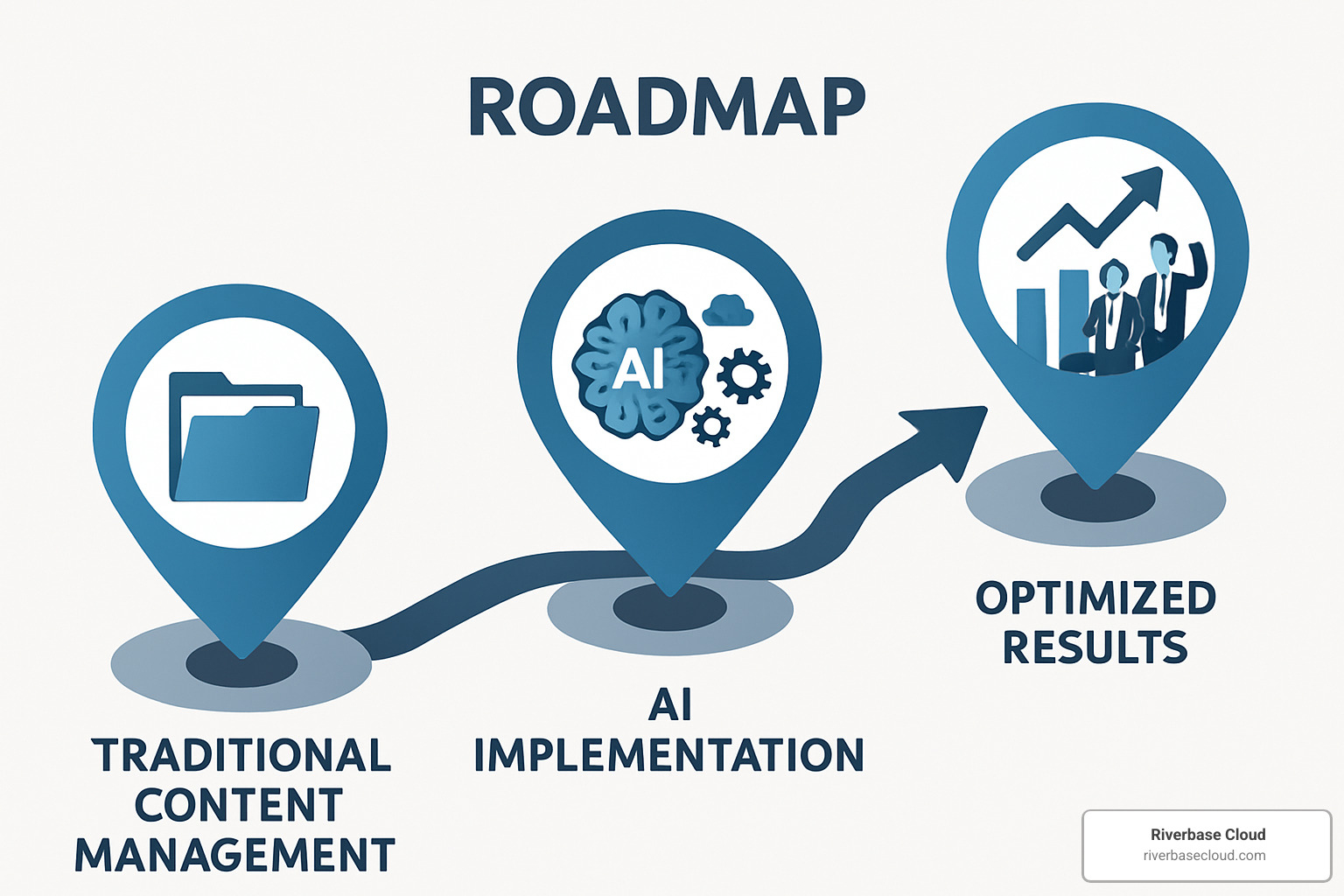
We're living through the most exciting change in content marketing since the internet changed everything. AI-powered content management isn't just another tech trend—it's the difference between struggling to keep up and effortlessly staying ahead.
Think about it: while your competitors are still manually creating content one piece at a time, you could be generating 10× faster content creation like Dentsu did. While they're drowning in administrative tasks, you could cut those costs by 80% through intelligent automation. While they're guessing what content works, you could see 286% more engagement through AI-powered personalization.
The numbers don't lie. Organizations implementing AI-powered content management achieve a 320% return on investment within the first year. That's not wishful thinking—that's measurable business impact.
But here's what really matters: the most successful implementations aren't about replacing humans with machines. They're about amplifying human creativity with AI acceleration. The best content still needs strategic thinking, brand understanding, and that indefinable human touch that builds real connections.
This is exactly why we created our Managed-AI approach at Riverbase Cloud. We've seen too many businesses get overwhelmed by AI complexity or disappointed by tools that promise everything but deliver confusion. Our Managed-AI CONTENT solution gives you all the benefits—faster creation, better optimization, higher rankings—without the headaches.
You don't need to become an AI expert. You don't need to manage complex systems or worry about staying current with rapidly evolving technology. We handle the technical details while you focus on what you do best: running your business.
The future belongs to businesses that can create exceptional content at scale. AI-powered content management provides the speed and efficiency, but human insight provides the strategy and soul. When you combine both thoughtfully, magic happens.
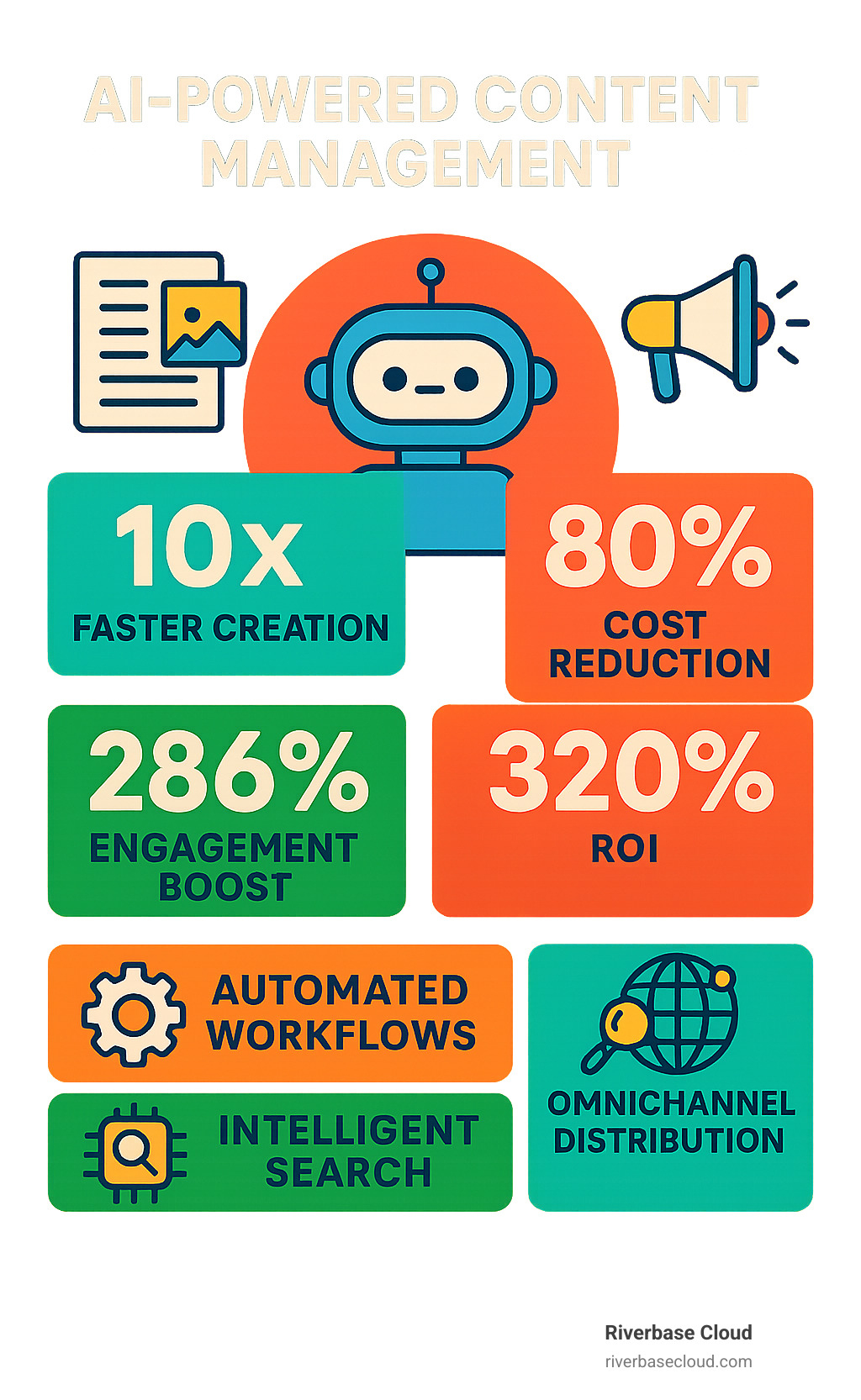
Ready to see what AI-powered content management can do for your business? Our commitment-free approach means you can experience the change without the risk. No long-term contracts, no hidden fees, no pressure—just results you can measure.
While AI accelerates your growth, our human expertise ensures every piece of content serves your unique business goals. It's the perfect partnership for the modern marketing world.
Boost your content results with Managed-AI CONTENT and find how the right combination of artificial intelligence and human insight can revolutionize your content marketing forever.
